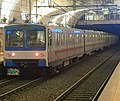History
Despite its name, Line B was the first metro line in Rome. The line was planned during the 1930s by the Fascist government in search of a rapid connection between the main train station, Termini, and a new district to the south-east of the city, E42, the planned location of the Universal Exposition (or Expo), which was to be held in Rome in 1942. The exposition never took place due to Italy's entrance into World War II in 1940. When work was interrupted some of the tunnels on the city-centre side of the metro (between Termini and Piramide) had been completed and were used as air raid shelters during the war.
Work on the metro began again in 1948, in concert with turning the space, formerly designated for the Expo, into a commercial district under the name Esposizione Universale Roma (EUR). The line was officially opened on 9 February 1955 by the President of the Republic Luigi Einaudi. Regular services began on the following day. [4]
When the new east–west line began service in 1980 from Anagnina to Ottaviano, it was named Line A, while the existing Termini-Laurentina line was renamed Line B.
In 1990, Line B was extended from Termini to Rebibbia to the east of the city, and the entire line was modernised. A spur called B1 opened on 13 June 2012. [5] It is a branch of Line B from Bologna to Jonio with 4 stations: Sant'Agnese/Annibaliano, Libia, Conca d'Oro, and the branch's new terminus at Jonio, opened on 21 April 2015).
Line B has 26 stations with terminuses at Rebibbia, Jonio and Laurentina (just east of EUR).
Opening dates
- 9 February 1955: Termini – Laurentina
- 8 December 1990: Termini – Rebibbia
- 13 June 2012: Bologna – Conca d'Oro (B1)
- 21 April 2015: Conca d'Oro – Jonio (B1)
Rolling stock
When the B line opened in 1955, MR100 and MR200 trains (also collectively known as Automotrice Stanga-TIBB) were used, and were transferred to the Rome-Lido railway in 1987, replaced by Series MB100 trains introduced in the same year, not only to replace the ageing MR100 and MR200 trains but also to cope with an increase in passengers following the opening of the eastward extension to Rebibbia.
Since 2010, Line B has also used the newer CAF MA300 and from 2014, MB400 Series trains similar to those on the Line A.
This page is based on this
Wikipedia article Text is available under the
CC BY-SA 4.0 license; additional terms may apply.
Images, videos and audio are available under their respective licenses.

















